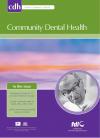Community Dental Health

- Cover Date:
- June 2008
- Print ISSN:
- 0265 539X
- Vol:
- 25
- Issue:
- 2
The influence of early counselling on weaning from a bottle
Objectives: To evaluate the effectiveness of intensive counselling on bottle weaning. Methods: A randomised prospective controlled study was conducted. Parents of 4-month-old babies who attended an inner-city clinic affiliated with the Department of Paediatrics, University of Louisville, Louisville, Kentucky with predominately African-American, indigent population were invited to participate. The parent/infant pairs were randomized to either intervention or control groups. Demographic information was recorded and both groups were surveyed on the parent’s beliefs and knowledge of weaning from the bottle. The intervention group parents received scripted counselling, including use of feeding cups, and were shown pictures of severe early childhood caries and a dental model of early childhood caries at four, six, nine, and 12 month visits. Two paediatricians who are on the clinic staff used the same script when talking to parents while showing the same photos and dental model to assure symmetry. The control group parents received brief counselling on the use of a feeding cup at 6 month and bottle weaning at nine and 12 months with no photographs or dental models shown. Two dentists, blinded to the group assignment, examined all of the children between the ages of 12 months and 24 months. Results: One hundred eighty-five parent/infant pairs were enrolled and 132 pairs (65 control and 67 intervention) remained at the end of the study. Demographic variables, socioeconomic status and race were similar for both groups. When surveyed, more of the control mothers believed that children should be weaned by 12 months (p=0.049). Yet, only 17% of their infants were weaned by 12 months, compared to 27% of the intervention infants (p=0.168). Conclusion: This small study demonstrated no change in parental behaviour after intense counselling.
Key words: baby bottle, dental caries, weaning
- Article Price
- £15.00
- Institution Article Price
- £
- Page Start
- 115
- Page End
- 118
- Authors
- S. Franco, J. Theriot, A. Greenwell
Articles from this issue
- Title
- Pg. Start
- Pg. End
- Editotial - Do we let children’s teeth decay just because some people object to topping up the natural fluoride that’s already in our water?
- 66
- 69
- Dental caries rates in primary teeth in 2002, and caries surveillance trends 1981-2002, in a South African city.
- 79
- 83
- Individual and maternal determinants of self–reported dental health among Turkish school children aged 10-12 years.
- 84
- 88
- Comparison of ranking dental status using the Significant Caries Index and the Significant Filled and Sound-Teeth Index
- 103
- 106
- Measuring oral health behaviour in Flemish health care workers: an application of the Theory of Planned Behaviour
- 107
- 114
